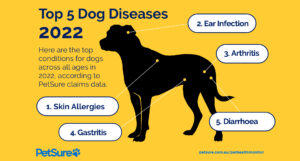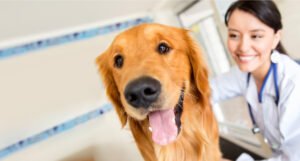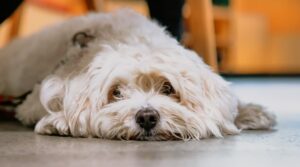Goldendoodle | Traits | training | Typical health problems
The section below outlines a Golderndoodle traits, training and typical health problems.
Goldendoodle | Breed highlights
| Breed: | Goldendoodles are medium to large crossbreed dogs. They are considered very friendly, affectionate, loyal and intelligent. |
| Coat type: | This crossbreed has wavy to curly coats; the fur is soft, can grow long, and is dense in appearance. |
| Shedding: | Goldendoodles can be low shedding (shedding amounts can vary from dog to dog). |
| Grooming: | Daily brushing is needed to keep the fur mat and tangle-free. In addition, Goldendoodles require regular professional grooming. |
| Activity level: | Moderate to high. Goldendoodles are active and need at least 30 minutes of exercise daily, including walking, running and swimming. |
| Apartment friendly: | Smaller Goldendoodles bred from Toy or Miniature Poodle parents can adapt to apartment living; however, those bred from Standard Poodle parents need a larger dwelling. |
| Small children: | Yes. Goldendoodles are gentle-natured and get on well with small children (supervision is always recommended). |
| Other dog friendly: | Yes. Goldendoodles are social and interact well with other dogs and other animals. |
What type of breed is a Goldendoodle?
Goldendoodles, also known as ‘Groodles’ are a hybrid breed, a cross between a Golden Retriever and a Poodle (Standard, Miniature or Toy). Goldendoodles are part of the poodle-cross group of dogs known as ‘oodles’.
History of the Goldendoodle
Anecdotal evidence suggests Goldendoodles were bred in 1969 by the great-granddaughter of Charles Dickens, Monica Dickens, who crossed a Golden Retriever and a Poodle. While a possible theory, Goldendoodles were widely bred in the 1990s in America and Australia, following in the footsteps of other popular poodle breed mixes, namely Cavapoos and Labradoodles. Since making a splash on the designer dog scene, Goldendoodles have continued to rank highly on the must-have dog list – no doubt due to their teddy bear looks and sweet, gentle natures. Like Cavapoos and Labradoodles, Goldendoodles have a breeding legacy that means they are considered low-shedding and possibly allergy-friendly.
Goldendoodle appearance and characteristics
Goldendoodles – no matter their age – tend to resemble giant puppies. They are recognisable by their textured shaggy coats. The fur is neither curly nor straight and, much like a teddy bear, is tufted in appearance. Generally, Goldendoodles have dark brown round eyes, a shortish snout and a black button-like nose (although some variations may have a pink or reddish coloured nose). Goldendoodles can be golden-hued, although they may come in black, brown, cream, apricot and shades of tan.
How tall a Goldendoodle grows depends on its Poodle parent. Those bred with Standard Poodle parents reach a height of 55 – 60 centimetres and, when fully grown, weigh up to 37 kilograms. Miniature (mini) Goldendoodle are those mixed with Toy or Miniature Poodle parents. This variety is smaller in size and weight. Toy Poodle crosses stand between 45 – 50 centimetres and weigh up to 20 kilograms, while Miniature Poodle crosses stand between 35 and 40 centimetres and weigh up to 11 kilograms.
Goldendoodle personality and temperament
As far as crossbreeds go, Goldendoodles are considered friendly and gentle. Their amicable personality is drawn mainly from the Golden Retriever, a breed known for its easy-going disposition.
In addition to their relaxed demeanour, Goldendoodles are highly social, energetic and curious – attributes all drawn from the Poodle. As puppies, they need plenty of attention, and even as they mature, they will require a setting where they won’t spend long periods alone. Goldendoodles, while not anxious dogs as such, can react to boredom or loneliness with signs of anxiety which may appear in the form of excessive vocalising (barking) or other destructive behaviours like chewing.
Goldendoodle breed traits
Goldendoodles are intelligent. Their intelligence is inherited from both dog breeds, with the Poodle second only to Border Collies in canine smarts. As well as bright minds, they are naturally inclined to want to please. These factors make the Goldendoodle one of the more trainable crosses, which may be feasible for first-time dog owners who may lack confidence in dog handling.
As well as possessing above-average intelligence, Goldendoodles are considered excellent family dogs. They are adaptable, and have considerate personality, meaning that they can get along well with small children. In addition, their kindle nature allows them to get on with other animals and live harmoniously in households with cats.
While they can be somewhat boisterous as young pups (most settle around 18 months), Goldendoodles learn to respond to their owner’s commands quickly.
Goldendoodle Lifespan
Goldendoodles live around 10-14 years.
The dos and don’ts of caring for a Goldendoodle
Do: Make sure you brush regularly. Brushing may be required daily. A Goldendoodle’s fur, although fine, can become easily matted. Regular brushing keeps fur tangle-free.
Don’t: Overbathe your Goldendoodle. While the crossbreed will need regular grooming to ensure its coat doesn’t become overgrown, at-home bathing is only necessary for your Goldendoodle if they have become smelly or dirty. Too much washing can strip the fur of naturally-occurring oils and dry out the skin.
Do: Make sure to check the ears regularly. Goldendoodles have floppy ears and hairy ear canals and must have their ears checked regularly. To master this simple technique, Petsure has created a how-to guide with step-by-step instructions.
Common Conditions for Goldendoodle
| Conditions | Symptoms can include~ | Highest cost for a single treatment* |
| Gastrointestinal (tummy) Tract Condition | · Diarrhoea, vomiting or constipation. · Blood or mucous in stool/vomit. · Increased frequency/urgency passing stool. · Weight loss. · Loss of appetite and interest in food. · They may seem more tired than usual. | $21,387 |
| Ingestion of foreign item or toxin. | · Vomiting, diarrhoea, loss of appetite. · Abdominal pain, frequent stretching, vocalising or sensitivity to touch. · Lethargy. · Drooling. | $12,717 |
| Ear Conditions -including infections and allergies | · Scratching, rubbing, or pawing at one of both ears. · Head shaking · Odour or discharge from the ears ·Ears may be red or warm to the touch | $6,529 |
| Skin Conditions, including – infections and allergies | · Scratching, biting, or rubbing the skin. · Signs of irritation, including red skin, scabs, bleeding, pustules, or weeping. · Hair loss, flaky skin, texture changes, lumps or an unusual or unpleasant smell. | $10,403 |
| Arthritis | · Limping on an affected limb/s · Stiffness on rising · Reluctance to jump or head up and down stairs · Swelling on pet’s legs | $2,655 |
Disclaimer: Reimbursement for these claims would be subject to limits, such as annual benefit limits or sub-limits, benefit percentage, applicable waiting periods and any applicable excess. Cover is subject to the policy terms and conditions. You should consider the relevant Product Disclosure Statement or policy wording available from the relevant provider.* Please note that the values calculated are based on all claims for that condition and medically related conditions in each calendar year.
Types of pet insurance from PetSure
| Policy type | Policy description |
| Accidents | This product provides cover for specified accidental injuries up to an annual policy limit. Most policies will reimburse a stated Benefit Percentage that is typically 80% of eligible vet bills. Some condition sub-limits may also apply, with all annual limits resetting each year when the policy is renewed. It’s important to know that only defined accidents as listed in the policy’s Product Disclosure Statement will be covered (other conditions will not be covered). More information on what is typically covered and not covered in our find a policy page. |
| Basic care | This product provides limited cover for both specified accidental injuries and illness conditions, with a stated Benefit Percentage that can range from 60-90%. Treatments and medications for eligible conditions are typically covered subject to the applicable policy limits. Claimable conditions have an annual condition limit , meaning once the condition limit (subject to the annual benefit limit) has been reached in an annual policy period, costs relating to that condition will need to be covered entirely by the policyholder. However, annual benefit limits and applicable annual condition limits reset on renewal each year. More information on what is typically covered and not covered in our find a policy page. |
| Comprehensive / Accident and Illness | This product provides comprehensive cover for both specified accidental injuries and illness conditions, with a stated Benefit Percentage that will typically range from 70-85%. You can claim up to an annual maximum limit each year, which resets on renewal. Sub-limits for certain items may also apply. More information on what is typically covered and not covered in our find a policy page. |
Frequently Asked Questions
Goldendoodles are generally considered a healthy breed. One of the key health problems to be aware of is skin allergies like atopic dermatitis. Dogs with skin conditions might show signs of constantly scratching, be itchy around the ears and licking their feet.
Overall, Goldendoodles don’t bark much. If they are barking excessively, this may be a result of loneliness or boredom. Sometimes an excitable or happy Goldendoodle may bark as well, but this type of barking is of no concern and can be managed with command training.
The ten Goldendoodle names for 2022, according to Petsure are:
1. Teddy
2. Daisy
3. Luna
4. Charlie
5. Archie
6. Murphy
7. Winnie
8. Ruby
9. Alfie
References
https://www.dailypaws.com/dogs-puppies/dog-breeds/goldendoodle
https://www.petculture.com.au/breeds/golden-doodle-groodle
Pet insurance can help by covering a portion of the eligible vet bill if the unexpected happens. Because it is difficult to predict the costs of veterinary care, it can help to have measures in place to help prepare for the unexpected. Check out our partner network and explore our policy tools to find a pet insurance policy.
Not all conditions or items are covered by Pet Insurance. Refer to the applicable Product Disclosure Statement for information about coverage and exclusions.



 Fact checked
Fact checked





